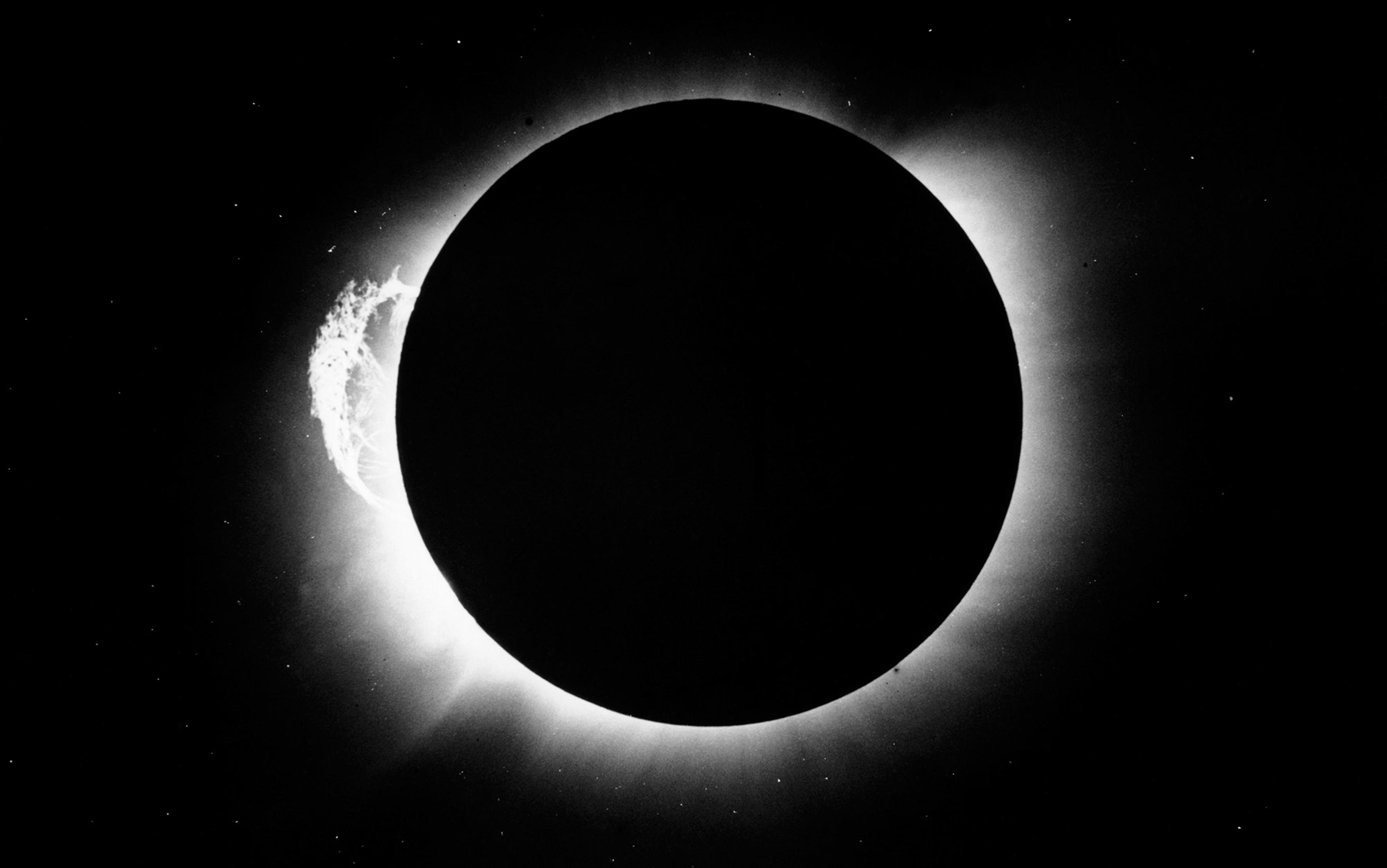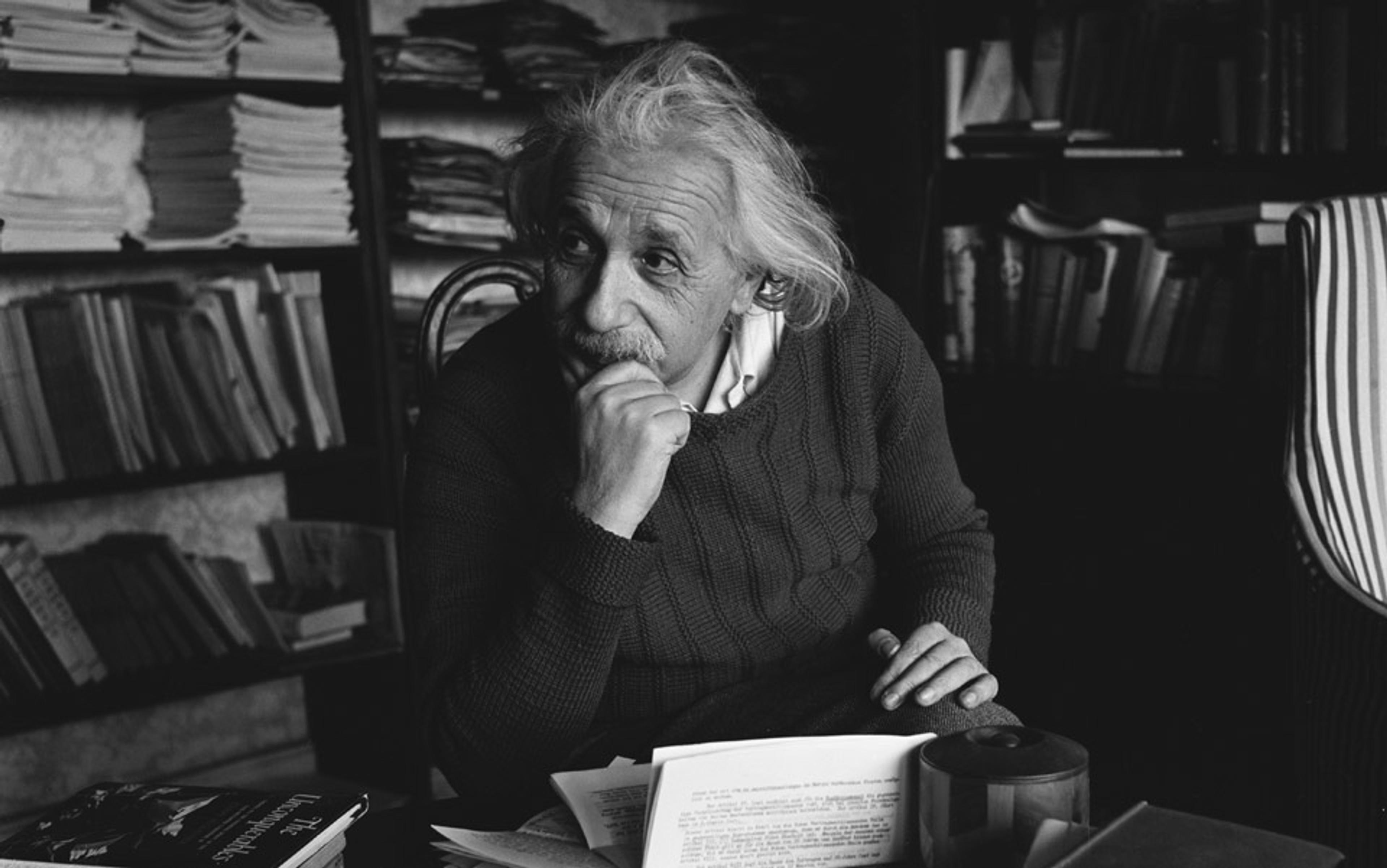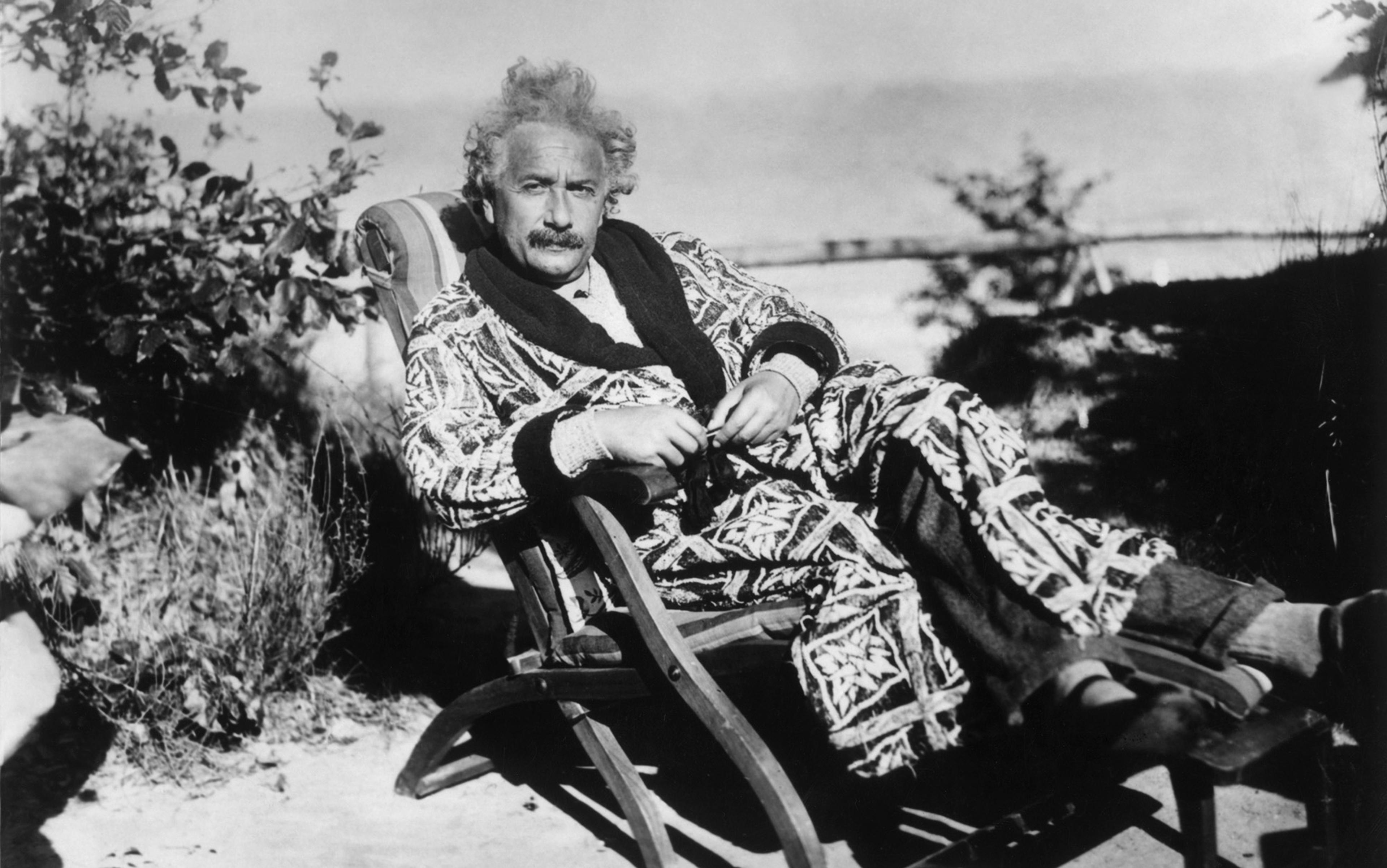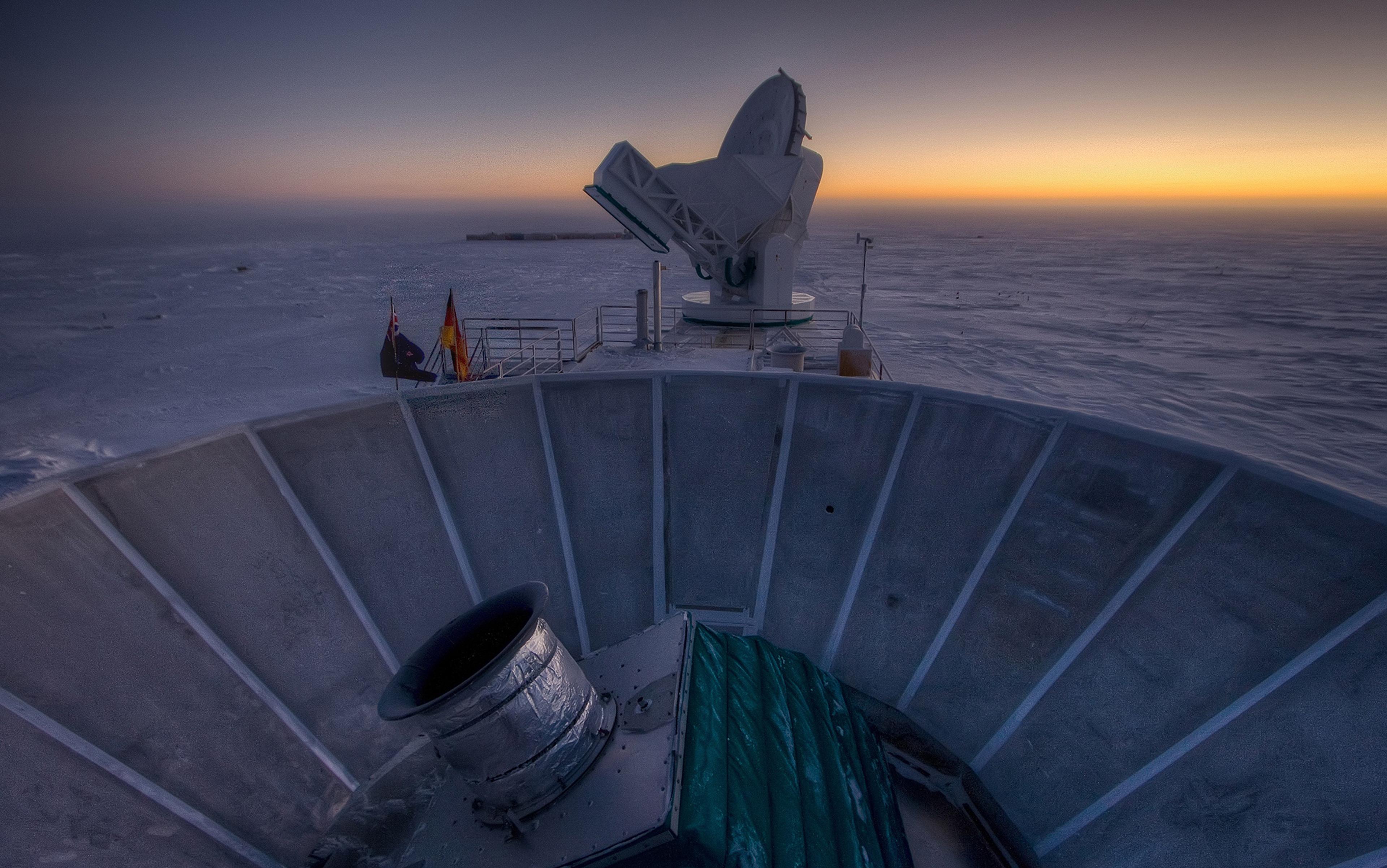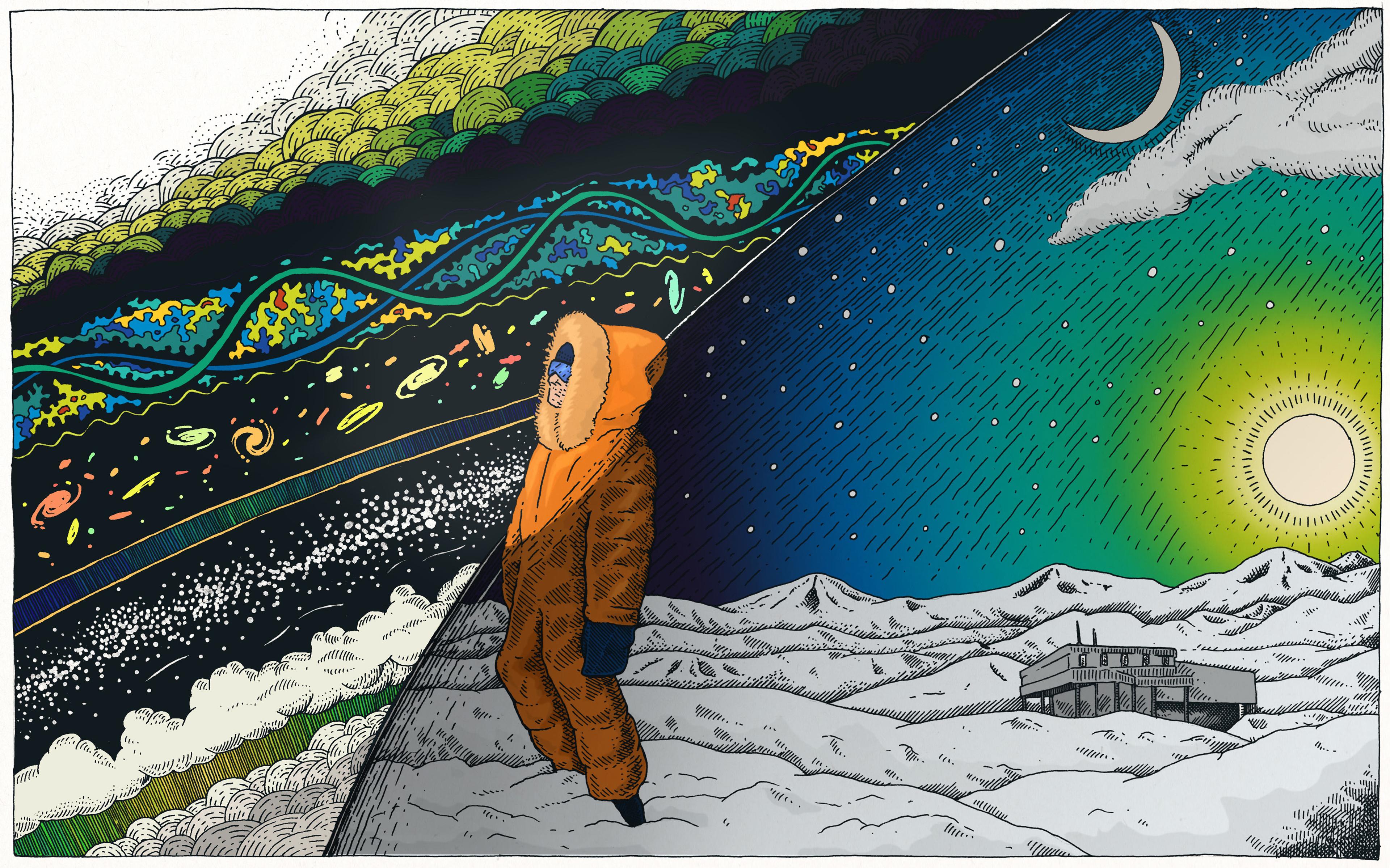Usually, when scientists test a theory, they get everything nicely under control. But in 1919, as the First World War was drawing down, the British astronomer and physicist Sir Arthur Stanley Eddington did not have that luxury. He was going to test Albert Einstein’s theory of relativity at a solar eclipse thousands of miles from the nearest precision laboratory. This was not easy. ‘In journeying to observe a total eclipse of the Sun, the astronomer quits the usually staid course of his work and indulges in a heavy gamble with fortune,’ wrote the young Eddington. For him, treacherous weather and war made true control even more difficult to attain.
Einstein’s situation was unstable as well. Berlin, his scientific space, was increasingly messy. His lectures on relativity were postponed because the university lacked coal to heat the lecture hall. Temporarily in Zurich to deliver lectures, Einstein found a lack of interest there too; only 15 students registered to hear him speak about relativity – and the university cancelled the event.
Back in Berlin, it was hard to know that the war was over, and there would be no true peace until the warring countries could agree upon a binding treaty. The negotiations involved setting up the League of Nations, as well as dividing Africa and the Middle East into new colonial possessions. As the scientists pursued their work, victorious empires gobbled up ever more of the world.
Those new imperial boundaries were of huge importance to astronomers planning solar-eclipse expeditions for May 1919. The first step for Eddington and his fellow physicist, the Astronomer Royal Frank Watson Dyson, was simply to figure out where and when the eclipse would be visible. The zone of totality – the place from which the Moon completely blocks the Sun – is typically some miles wide, but the eclipse is visible only for minutes (if one is lucky). The shadow of the Moon hurtles across the surface of the Earth at more than 1,000 miles per hour, and astronomers need to be in the right place at the right time with their telescopes and cameras. The path of totality was an arc across the Southern Hemisphere from Africa to South America. Many factors entered into the choice of where to make the observations: did the location have a reputation for good weather? How low in the sky would the eclipse be? Were there nearby steamship and railway networks to carry the astronomers and their heavy equipment? Was a telegraph station close by?
Dyson and Eddington ultimately decided that there were two locales – each would have about five minutes of totality – that best met all these conditions, one on each side of the Atlantic. Sobral, a city 80 miles inland in Brazil, was on the rail lines. It was not quite in the centre of the path, so totality would be a few seconds shorter. But the logistical advantages more than made up for that. Word was that the rainy season would be over by May, though no one was sure.
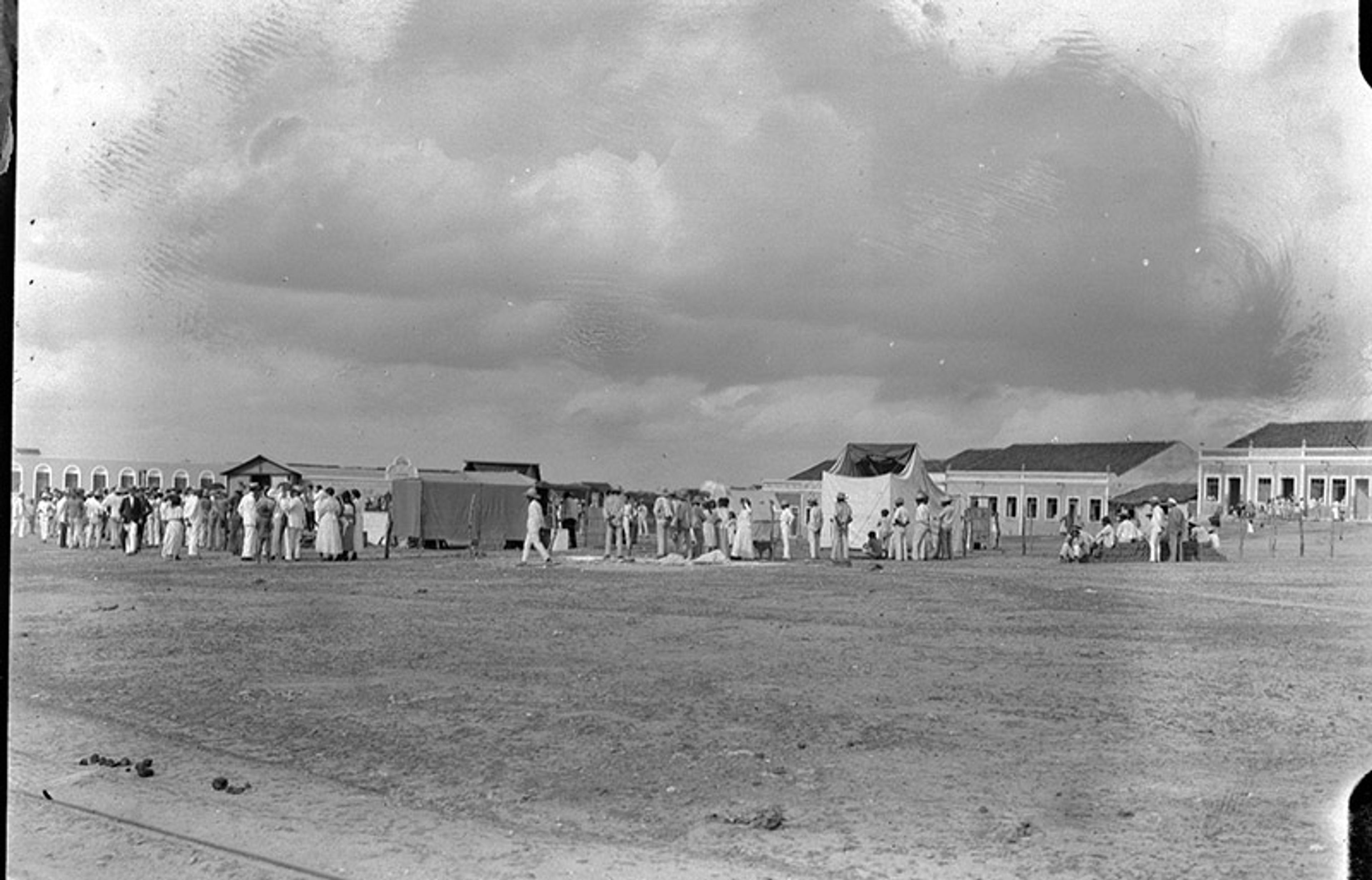
Townsfolk gathered moments before the eclipse in Sobral, Brazil, on 29 May 1919. Courtesy the National Observatory, Brazil
The other observation site was Príncipe, an island 110 miles off the west coast of Africa just north of the equator. It was under Portuguese imperial possession and known for its cocoa exports. The chocolate industry meant both that it was served by a fortnightly steamer from Lisbon, and that there was likely European-style infrastructure there. Its isolation in the ocean was a positive feature – being surrounded by water meant more stable temperatures throughout the day and easy sight-lines to the horizon.
Dyson had been given £1,000 for travel costs in 1918 (about $75,000 today). During wartime, that was an enormous grant – he decided he could stretch that money to cover expeditions to both sites, important insurance against bad weather or other mishap, dramatically increasing the chance of success.
Eddington would go to Príncipe, accompanied by Edwin T Cottingham, a clockmaker who had worked for years with both Dyson and Eddington maintaining the timepieces at their observatories. Meanwhile, the observations in Sobral were conducted by Charles Davidson, who had a reputation as an absolute wizard with mechanical devices and scientific instruments. Dyson trusted him implicitly to make any mechanism work properly.
The equipment that Davidson had been preparing included three carefully chosen telescopes. Eddington needed crisp images of stars, not something that eclipse-observers usually look for. So the teams decided to use astrographic telescopes – specially designed to capture precise, faint images. Dyson tried to secure two telescopes of this sort that had been used at previous eclipses. One mounted in Greenwich was easily acquired. The other was at the Oxford observatory overseen by H H Turner, the most vocal anti-German astronomer in the country. We do not know how Dyson persuaded Turner to contribute this valuable instrument to Einstein-centric expeditions, but somehow he succeeded.
Even with the right equipment, in 1919 these measurements were outrageously complicated. Because the Earth rotates, the eclipsed Sun and the stars appear to move across the sky. Even over the course of just a few seconds, this apparent motion will blur the images on the photograph. One solution to this problem is to mount the telescope on a pivot and slowly turn it to match the Earth’s movement. But this is not a very good solution for an expedition – telescopes are heavy and large, and very difficult to move without shaking or bending, which would ruin the image. The traditional answer was to use a coelostat, a kind of ‘clockwork mirror’ that Eddington had used in the past.
The telescope would be laid horizontally, nicely stable. The lens of the telescope would be pointed at the coelostat mirror, which would then be adjusted so that the image of the Sun would fall in the middle of the camera. Then the mirror could be turned smoothly during the eclipse to keep the image centred without blurring.
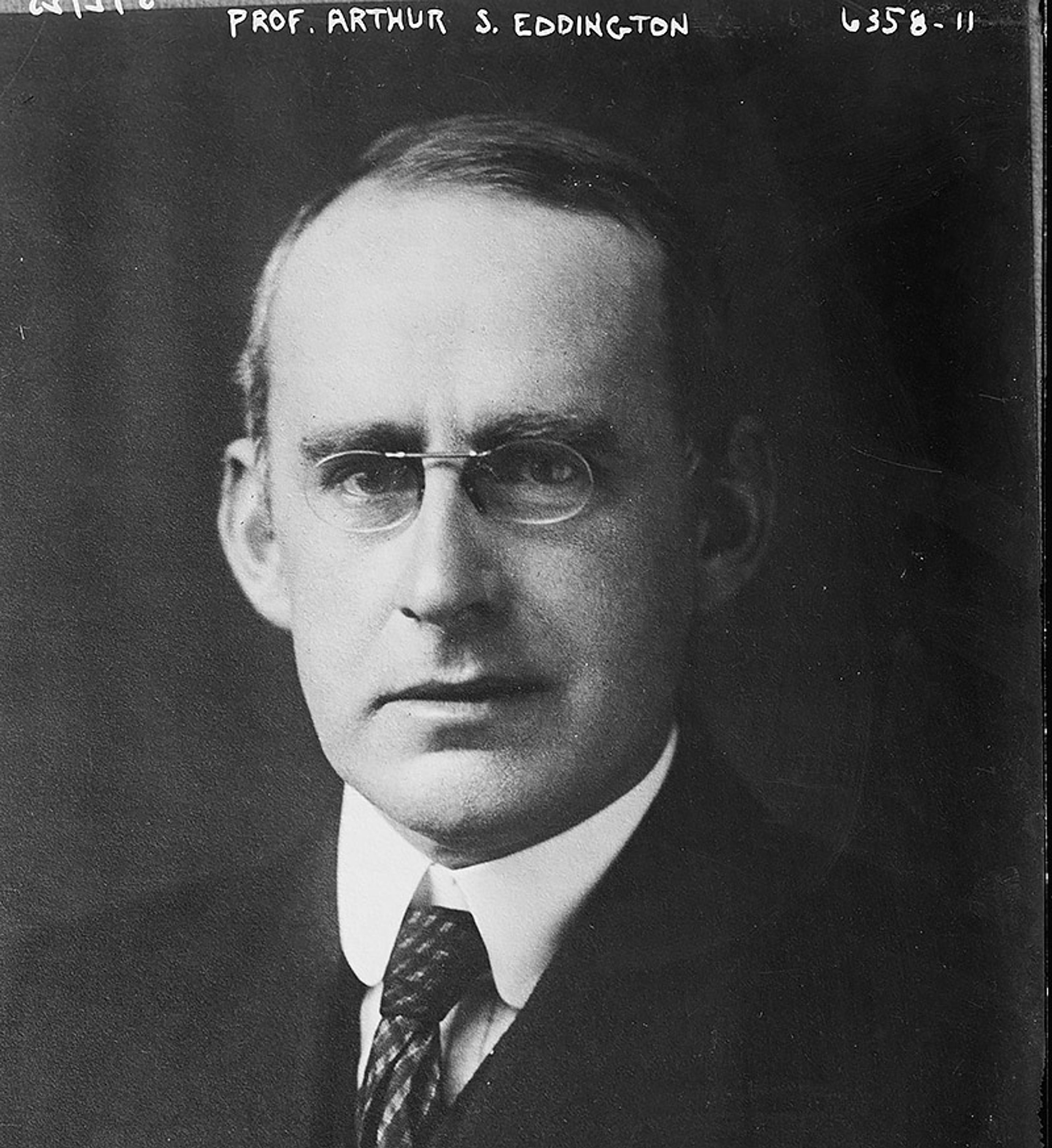
Undated photograph from a glass plate of Arthur Eddington. Photo courtesy the Library of Congress
Greenwich had a set of these coelostats that had been used for many previous expeditions. Unfortunately, they were old and unreliable. Normally, overhauling them would be a straightforward, if tedious, process, but the early preparations for the expeditions were happening during wartime, and a ‘priority certificate’ from the Ministry of Munitions was required to get any precision work done. So, as a backup, the researchers brought along some small, four-inch telescopes – just in case.
The expeditions were not passive attempts to look for something interesting during the eclipse. Their goal was to test a specific prediction of Einstein’s theory of relativity. Einstein had said, let’s look at a star that appears to be just at the edge of the Sun’s disk (the star was actually trillions of miles away, it just happened to line up with the edge). The image of that star is being carried to us by a ray of light. As that light passes by the Sun, the curvature of space-time there (created by the Sun’s gravity) will bend that ray of light. To an observer on Earth looking at the star’s image, the bending means that the image will be shifted slightly from its original location. General relativity predicted the exact angle between where the star should be when the Sun’s gravity was not in the way, and where it appeared to be when the Sun’s gravity was. That angle was measured in arc-seconds (one-60th of one-60th of a degree). Einstein said the change should be 1.75 arc-seconds. On the photographic plates Eddington would be using, that would translate to about one-60th of a millimetre.
It was a moment for this upstart German to dethrone the greatest thinker in history
Astronomers were able to make these precise measurements because they took everything into account. Photographs taken during the eclipse needed to be compared with photographs of the same field of stars when the eclipsed Sun is not in front of them. It is the change of position of the star that matters – they had to have an exact reference for that change. It can take months for the Sun to move far enough across the sky that the images would be undistorted by its gravity.
That means a second set of photographs would have to be taken either months before or after the eclipse itself. Further, they had to be taken with exactly the same lens and photographic setup – every lens is a little bit different, and it was essential to make sure that an apparent change in the star’s location was not due to an imperfection introduced by a different lens. So photographs of the stars they would measure were taken from England with the lenses they planned to use in the field.
Hoping to get those preliminary results home as soon as possible, Eddington and Dyson even arranged a special telegraphic code. Before his departure, Eddington wrote an article presenting all this information to his colleagues so they would know how to interpret the results as they came back. Eddington declared that there were three possibilities: no deflection; 1.75 arc-seconds, the Einstein prediction; or 0.87 arc-seconds, which would support Newtonian gravity and challenge the ideas of Einstein. Eddington made a shrewd choice in framing the possible results this way. The test suddenly became a direct struggle between Einstein and Newton – a single moment in which this upstart German could dethrone the greatest thinker in history. Eddington had created a narrative and a thrilling background against which to present the expeditions’ results.
Eddington was in a hurry to get his show on the road. At the beginning of March, he embarked upon a 5,000-mile ocean journey, arriving off the coast of Africa with Cottingham on 26 April. The two men stayed in the port of Santo António on Príncipe for about a week as they scouted the island for the best observation sites. They finally decided on the Roça Sundy Plantation on the northwest corner of the island, away from the cloud-gathering mountains, on a plateau overlooking a bay 500 feet below.
The locale and date of 29 May were propitious indeed. This particular eclipse, it turned out, would take place right in front of the Hyades, a handful of bright stars perfect for measuring the Einstein deflection. Eddington wanted bright stars so they could be easily seen on the photograph. And he wanted more than one so he could see how the deflection changed the farther away from the Sun they were: a star right at the edge of the Sun should show the 1.75 arc-second deflection; a star slightly farther away would show less; a star well away would show almost none. Einstein predicted not only a deflection but also a specific way that the deflection would change with distance from the Sun’s edge. Multiple stars meant that this aspect of the prediction could be tested as well.
A past or future astronomer might have to wait centuries or millennia for a background as auspicious as the Hyades. They are found in the constellation Taurus. The Hyades are the bull’s head, right by the blazing-red star Aldebaran. They were named after five nymphs, the daughters of Atlas. Weeping over the death of their brother, they were placed in the heavens just out of Orion’s lustful reach. As one of the brightest clusters in the sky, they are visible to the naked eye and have been watched since antiquity. The Hyades are among the constellations placed on the shield of Achilles, along with Orion and Ursa Major. They were part of the ancient links between the heavens and the Earth, carrying meaning from the celestial realm to the terrestrial.
Eddington had no shield on which to catch these stars, only a telescope with which to look for their message. To see if the light from those stars was bent, he had to point that telescope into the darkness of a total eclipse, when the temperature drops, birds stop singing, and (crucially for Einstein) the stars become visible.
They cabled home immediately: ‘Eclipse splendid’
Thursday 29 May 1919 was cloudy in Sobral. The local community had been preparing to make the eclipse a public event, and festivities were ready to go. A small observatory near the edge of the eclipse path sold tickets to look through a telescope. The clouds were still thick at the beginning of the eclipse. When the leading edge of the Moon touched the solar disk (a moment called ‘first contact’), the astronomer Andrew Crommelin, who had accompanied Dyson, estimated that 90 per cent of the sky was clouds. But they rapidly diminished, and the Sun sat in a large, clear patch as totality began.
The landscape was plunged into surreal darkness and the astronomers began their work. One of the Brazilians watched a clock and called out the passage of seconds for timing the photographs. Nineteen photos were exposed with the large telescope, and eight with a small four-inch lens. The clear sky held for the entire eclipse; everything had gone smoothly. They cabled home immediately: ‘Eclipse splendid.’
On the other side of the Atlantic, the Príncipe dignitaries came to visit Roça Sundy on the morning of the eclipse. They were immediately greeted by a tremendous rainstorm, the heaviest the British visitors had seen, and quite unusual for that time of year. It ended around noon, with a couple hours to go before the eclipse. The clouds, Eddington said, ‘almost took away all hope’.
At first contact, the Sun was invisible behind the clouds. It was not until 1:55pm that the astronomers began to get glimpses of the Sun, shaped into a crescent by the Moon’s inexorable creep. It slipped in and out of cloud from moment to moment. Even in good conditions, the last few seconds before totality have been described as ‘almost painful’. We can only imagine what this kind of knife-edge waiting would have felt like. Totality was calculated to begin five seconds after 2:13pm. At that moment, the astronomers became machines, carrying out the planned procedures regardless of what they could see with the naked eye – machines, though driven by hope and anticipation. As Eddington described it: ‘We had to carry out our programme of photographs in faith.’ The telescope took all of their attention. Cottingham kept the coelostat mechanism running and handed Eddington fresh plates; Eddington removed the exposed plates and slid in the new ones. He had to pause for a delicate second after each swap, lest the motion caused some tiny tremor that would ruin the image.
When totality ended, the world returned to normal, with no lasting marker of the disruption of the natural order that had just taken place. Eddington could take a moment to breathe. His telegram to Dyson was succinct: ‘Through cloud. Hopeful.’
The decision had been made to develop the photographs onsite in Brazil and on Príncipe, and for reasons ‘not entirely from impatience’. The glass plates were delicate and could easily be damaged on the long journey home. Developing them in place and making preliminary measurements would at least guarantee some results, even if they were gathered in imperfect conditions. In Sobral, Davidson and Crommelin developed four of the astrographic photographs the next night. They were shocked to see that the star images were ever so slightly distorted, as though the focus on the telescope had been changed.
This change of focus can be attributed only to the unequal expansion of the mirror through the Sun’s heat. The readings of the focusing scale were checked the next day, but were found unaltered at 11mm. It seems doubtful that much could be revealed from these plates. For normal eclipse observations, this effect would be negligible. But the Einstein deflection was such a small effect that it could easily be swamped by such a phenomenon.
The images from the four-inch telescope, brought along as an afterthought, looked much better. So not all hope was lost. In any case, the pair of astronomers had a long wait ahead of them. They needed to stay in Brazil until July to take check photographs of the Hyades once the Sun had moved out of the way. Eddington was not in a mood to wait. While there were good technical reasons to examine the photographs right away, it seems his incentive might have been more personal. For the six nights after the eclipse, he and Cottingham developed two plates each night. They were not quite what he wanted: ‘The first 10 photographs show practically no stars. The last six show a few images which I hope will give us what we need; but it is very disappointing.’
‘Einstein’s theory had stood the test: the new outlook of scientific thought must prevail’
Eddington then spent each day hunched over the photos with a complicated device called a micrometer making fine measurements. Even with Eddington’s legendary mathematical speed, it still took him three days of feverish work. It was more complicated than he expected because the cloudy images forced him to use different methods from those planned. But at some point in the first week of June 1919, Eddington put down the pen he had been using for his calculations. He had his answer: ‘I knew that Einstein’s theory had stood the test and the new outlook of scientific thought must prevail.’
However, this moment was just a matter of Eddington persuading himself. His preliminary calculations were not nearly enough to convince everyone back home. For that, a great deal of work remained. Eddington had hoped to stay on Príncipe to complete some of that work but his plan was disrupted by labour issues with the local steamship line. If he did not depart immediately, he might be stranded for an unknown length of time. The governor of Príncipe commandeered space for him and Cottingham on the last ship leaving that summer (the SS Zaire). Eddington came home to a new world of ‘international’ science, officially defined as ‘everyone except Germany and Austria’. But he had a trunk full of photographs intimately tied to a theory substantially developed in Berlin.
Scientific observations do not speak for themselves; they do not give up their secrets easily. Bringing the world around to his conclusion that Einstein was right would take Eddington months of tedious measurement and calculation.
Dyson and Eddington kept the expeditions separate even during the process of analysing the data. Perhaps it was thought that independent measurements would be seen as more reliable. The Príncipe photographs would be analysed in Cambridge, the Sobral ones in Greenwich. Eddington probably did the measurements and calculations for the former himself, while Davidson worked with Royal Observatory staff on theirs; the Sobral team had the slightly easier task. Because they were able to take check plates onsite, they could directly compare them with the eclipse photographs. Since both were taken in the same place with the same telescope, they could just measure how far the image of a certain star appeared to move when the Sun’s gravity was present.
However, this was not a matter of slapping down a ruler and lining up by eye. Small measurements were made with a micrometer that could assess much tinier distances than the human hand. These measurements required a great deal of training and patience, but were a standard part of an astronomer’s toolkit.
Eddington needed an extra step. He had been unable to take check plates from Príncipe, so he could not make a direct measurement. He had to compare the image of the Hyades he took during the eclipse with the image of the Hyades taken with the same telescope in Oxford. But he had to account for the possibility that there was some subtle difference between Oxford and Príncipe that changed the image. So he had taken an image of a different star field in both locations and, by comparing those two photographs, he could see what differences there were.
Armed with that information, he could then account for that in his final measurements. It is very rare that a measurement in science has no interference or error. Rather, the trick is to understand those problems and correct for them. The Príncipe observations produced 16 photographs, though thanks to the cloud only seven had useful images of stars. Fortunately, all seven had the two stars with the highest predicted deflection. However, a reliable measurement required five stars for cross-reference, and only two of the plates had that many. Those two were consistent, at least, and gave an average deflection of 1.61 arc-seconds, ± 0.30. That uncertainty was not superb, but it was adequate. Einstein’s predicted deflection was 1.75. For the first measurement of a completely unknown physical phenomenon, Eddington thought it was pretty good.
As for the work from Sobral, the four-inch backup telescope brought along at the last moment saved the day. Seven of the eight plates taken with it had excellent images of all seven hoped-for stars. Measuring those provided much better results than from Príncipe: 1.98 arc-seconds, ±0.12.
While Eddington and Dyson were furiously measuring and calculating, they somehow still made time to set the stage for the eventual presentation of the results. Dyson asked the Royal Society Council to schedule a special meeting on 6 November, at which the results would be formally presented. There was no turning back. Nonetheless, it was still impossible to send a message directly to Berlin, so they did the next best thing. The Dutch physicist Hendrik Lorentz sent a telegram to Einstein, urgent and brief: ‘Eddington found stellar shift at solar limb, tentative value between nine-tenths of a second [of a degree] and twice that.’
Unfortunately, we have no eyewitness account of Einstein first receiving the news. Fortunately, he then showed the telegram to anyone who came into his apartment, so we can see it through other eyes. Ilse Rosenthal-Schneider, a young physics student, was sitting with Einstein at his desk going through a book full of objections to relativity. Einstein suddenly interrupted their reading to reach for a document on the windowsill. He coolly remarked: ‘This may interest you,’ and handed her Lorentz’s telegram. Einstein could think of little else and was in no mood to be shy about spreading the word.
He was the peaceful genius who repudiated all the stereotypes of the militaristic German
That was the attitude Eddington was hoping to instil in his British colleagues at the Royal Society’s rooms at Burlington House in Piccadilly. The audience on 6 November was seated in pews, with an overflow crowd standing among the columns lining the sides. One of the attendees was Alfred North Whitehead, the distinguished philosopher-mathematician. He reported on the excitement in the air, writing: ‘The whole atmosphere of tense interest was exactly like that of the Greek drama.’
The next day, The Times newspaper in London presented the greatest scientific headline in history: ‘Revolution In Science’. The discovery was attributed to ‘the famous physician Einstein’ (he was neither). On Saturday there was a follow-up article with the same title, with the addition ‘Einstein V Newton’. This was the general public’s first introduction to Einstein, and he appeared exactly as Eddington wanted to present him: a peaceful genius who repudiated all the wartime stereotypes of the militaristic German.
The excitement jumped the Atlantic and, on 10 November 1919, The New York Times blared: ‘Men Of Science More Or Less Agog Over Results Of Eclipse Observations’. It is important to look back and remember that this was virtually the Times’ first mention of Einstein.
The explosion of interest finally made it possible for Eddington and Einstein to write directly to each other. ‘All England has been talking about your theory … it is the best possible thing that could have happened for scientific relations between England and Germany,’ Eddington wrote to Einstein later that year. The eclipse expedition became a symbol of German-British solidarity because Eddington chose to craft it that way. Einstein chose to fight against militarism in German science, raising the stakes. This was a great moment for science across the gulf of war because certain scientists turned it into one.
This is an edited extract from ‘Einstein’s War: How Relativity Conquered Nationalism and Shook the World’ (2019) by Matthew Stanley, published by Dutton, an imprint of Penguin Publishing Group, a division of Penguin Random House LLC. Copyright 2019 by Matthew Stanley.
